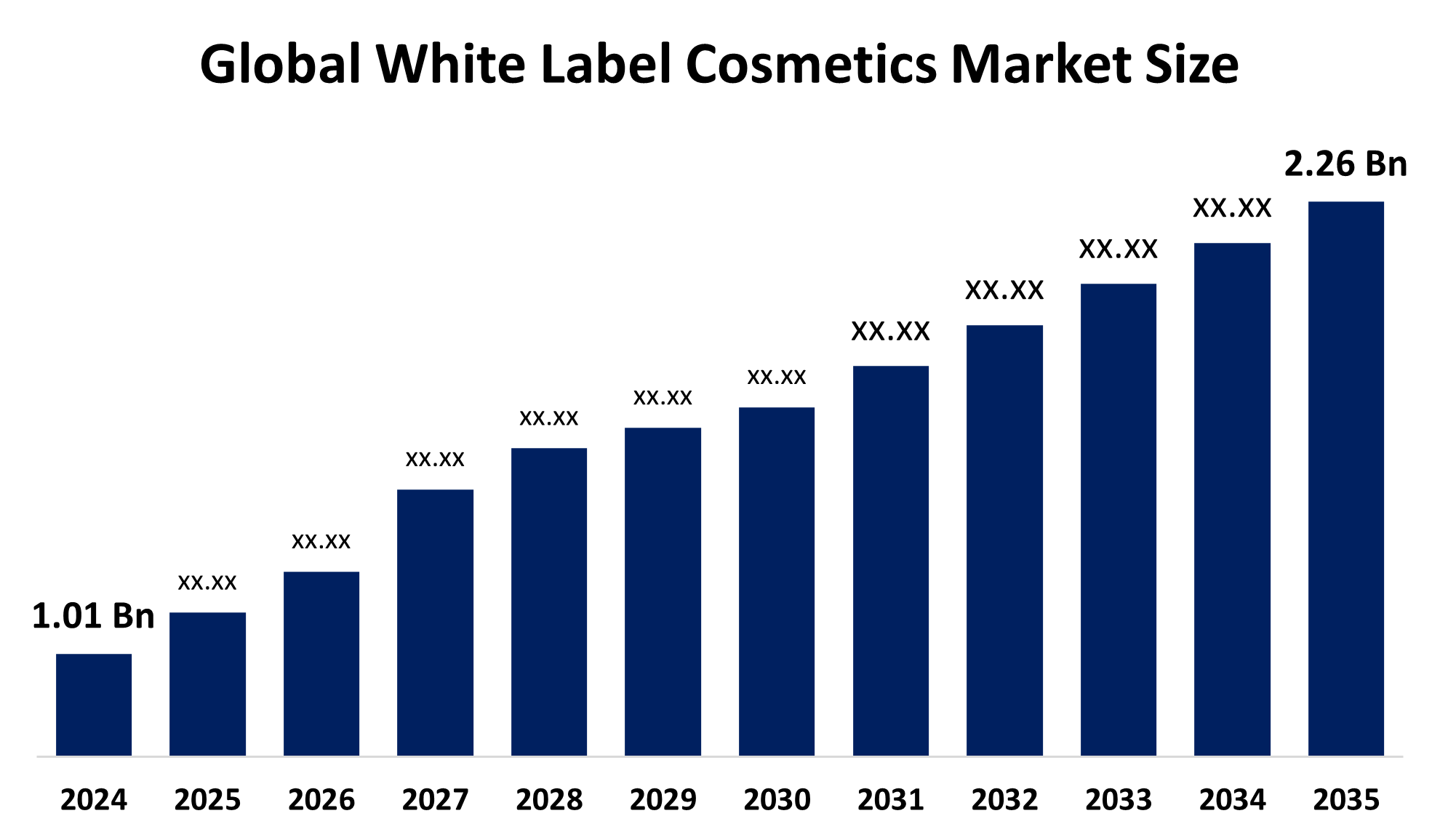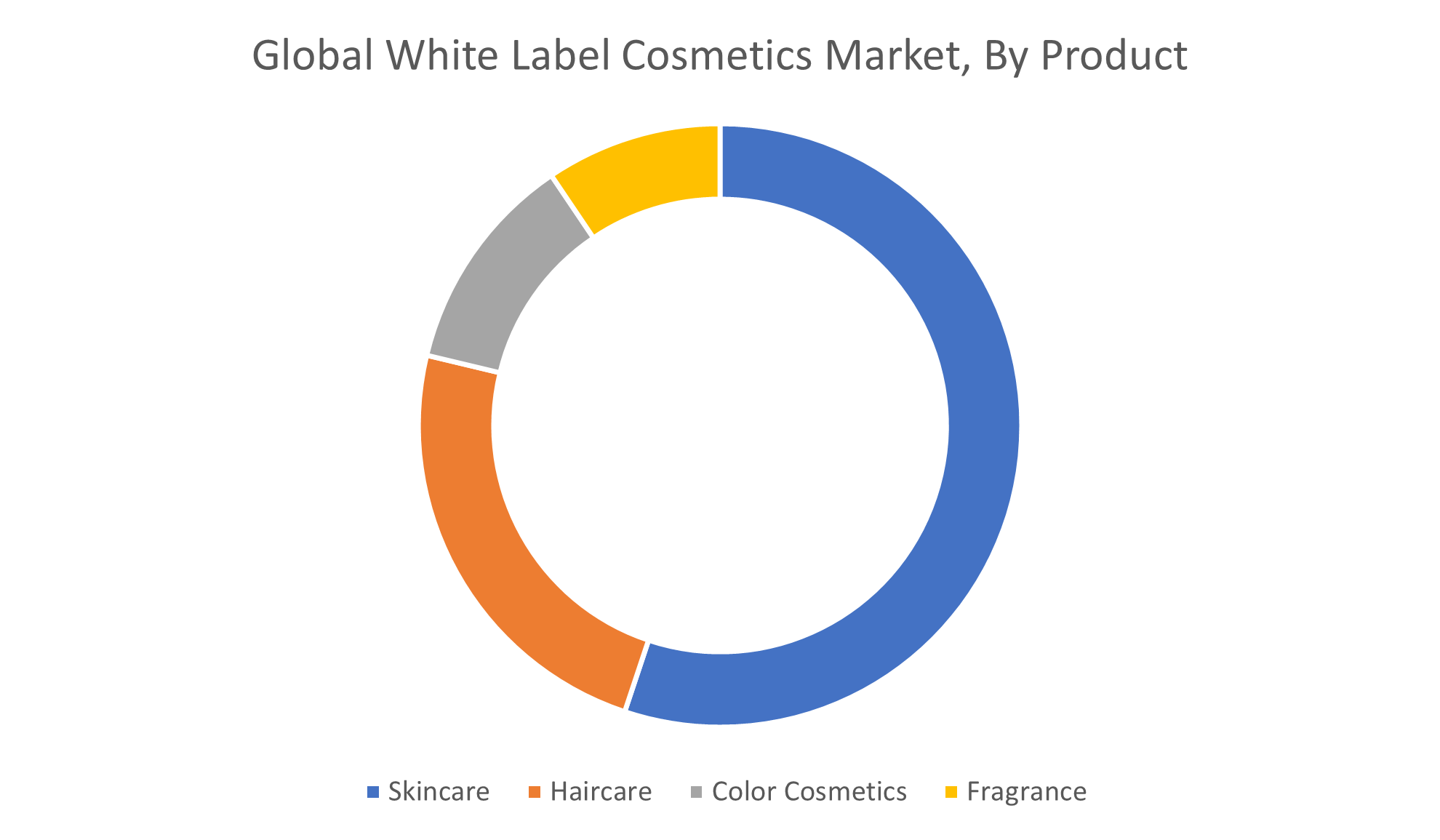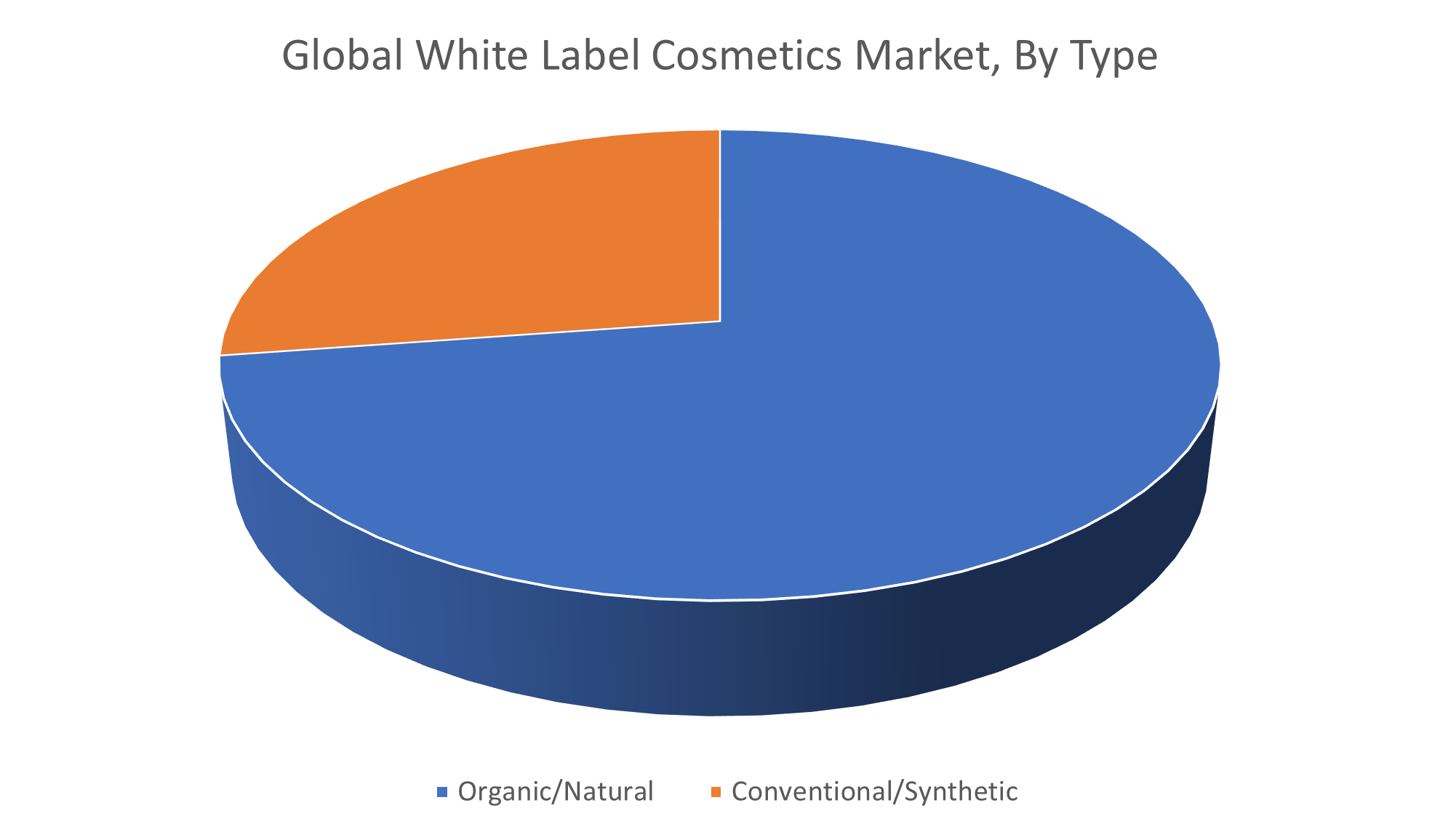Global White Label Cosmetics Market Insights Forecasts To 2035
- The Global White Label Cosmetics Market Size Was Estimated at USD 1.01 Billion in 2024
- The Market Size is Expected to Grow at a CAGR of around 7.60% from 2025 to 2035
- The Worldwide White Label Cosmetics Market Size is Expected to Reach USD 2.26 Billion by 2035
- Asia Pacific is expected to Grow the fastest during the forecast period.

White Label Cosmetics Market
The global white label cosmetics market involves the production of unbranded cosmetic and personal care products by manufacturers, which are then branded and sold by other companies. This model enables businesses to launch their own cosmetic lines quickly and cost-effectively without the need for in-house product development or manufacturing capabilities. White label cosmetics include a broad range of products such as skincare, haircare, makeup, and wellness items, offering flexibility in formulation, packaging, and branding. The market is supported by a wide customer base, including small businesses, beauty entrepreneurs, and influencers seeking to create customized beauty lines. E-commerce and direct-to-consumer channels play a significant role in the distribution of white label products, making it easier for brands to reach and engage consumers online. With its scalable structure and minimal entry barriers, the white label cosmetics industry continues to grow as more companies seek quick and efficient ways to establish a presence in the beauty market.
Attractive Opportunities in the White Label Cosmetics Market
- Leveraging artificial intelligence to create highly customized beauty products tailored to individual consumer needs, enhancing user experience and brand differentiation.
- Expanding into underserved markets such as men’s grooming, halal cosmetics, and age-specific skincare to capture loyal and targeted customer bases.
- Offering eco-friendly, recyclable, or biodegradable packaging to meet the rising consumer demand for environmentally responsible products without altering formulations.
- Implementing subscription services and product bundles to build customer loyalty and ensure steady revenue streams through convenience and personalized offerings.
Global White Label Cosmetics Market Dynamics
DRIVER: Increasing demand for personalized and private-label beauty products
One of the primary drivers is the increasing demand for personalized and private-label beauty products, as consumers seek unique offerings that align with their preferences and values. The rise of social media and influencer marketing has also played a crucial role, encouraging entrepreneurs and content creators to launch their own beauty brands with minimal upfront investment through white label solutions. Additionally, the shift toward clean, natural, and cruelty-free cosmetics is boosting demand for customizable formulations provided by white label manufacturers. The convenience and speed of launching products without the need for in-house R&D or manufacturing capabilities appeal to startups and small businesses. Growing online retail and direct-to-consumer sales channels further support market expansion by making it easier for brands to reach global audiences. These factors collectively contribute to the increasing adoption of white label cosmetics worldwide.
RESTRAINT: Lack of uniqueness, as many brands use the same products from the same manufacturers
The global white label cosmetics market faces a few key challenges that can slow its growth. One of the main issues is the lack of uniqueness, as many brands use the same products from the same manufacturers, making it hard to stand out. Quality control can also be a problem if the manufacturer doesn’t meet high standards, which can hurt a brand’s reputation. Another challenge is dealing with different rules and regulations in various countries, which can be confusing and expensive for smaller brands. Also, white label products often offer limited options for customization, especially for companies placing small orders. This can make it difficult to create truly unique products. Lastly, because the formulas are not owned by the brand, there can be concerns about copying or protecting product ideas. These factors can make it harder for brands to build strong customer loyalty and grow over time.
OPPORTUNITY: Technological advancements, such as AI-driven product personalization and smart beauty devices
One key opportunity lies in technological advancements, such as AI-driven product personalization and smart beauty devices, which manufacturers can integrate into white label offerings to attract modern consumers. Another promising area is the expansion into niche markets, such as men's grooming, halal cosmetics, and age-specific skincare, which remain underdeveloped yet show rising demand. There is also strong potential in offering eco-friendly packaging solutions, allowing brands to align with growing sustainability trends and differentiate themselves without changing product formulas. Collaborations between white label producers and emerging biotech firms may lead to innovative ingredients and functional skincare products, opening new revenue streams. Additionally, subscription-based models and bundling services for white label brands can create long-term customer engagement and predictable income. These opportunities allow brands and manufacturers to move beyond basic offerings and tap into evolving consumer expectations in a competitive market.
CHALLENGES: Tough competition from companies that create their own custom formulas
Apart from the usual limitations, the white label cosmetics market faces other challenges that can affect brand growth. One big issue is that it’s hard for brands to build a strong identity and loyal customer base when many are selling similar or generic products. There is also tough competition from companies that create their own custom formulas, offering more unique and appealing options. Beauty trends change quickly, and white label brands may struggle to keep up since they often rely on fixed product lines. Another challenge is supply chain problems, like delays or shortages of ingredients, which can affect product availability. Brands also depend heavily on third-party manufacturers, meaning they have less control over quality, pricing, and delivery. These challenges make it harder for white label brands to stand out, grow steadily, and meet customer expectations in a fast-changing beauty market.
Global White Label Cosmetics Market Ecosystem Analysis
The global white label cosmetics market ecosystem consists of manufacturers who produce unbranded beauty products, raw material and packaging suppliers, and brand owners who rebrand and sell these products. Supporting players include marketing agencies and regulatory bodies that ensure compliance and help with branding. Distribution occurs through e-commerce, retail, and direct-to-consumer channels. This interconnected network enables quick product launches, customization, and efficient market entry for new and existing brands, driving growth and innovation in the cosmetics industry.
Based on the product, the skincare segment accounted for a revenue share of the white label cosmetics market over the forecast period

The skincare segment dominance reflects the growing consumer interest in personalized skincare routines and effective, ready-made products. Brands are increasingly leveraging white label solutions to meet this demand, offering a range of skincare items such as cleansers, moisturizers, serums, and anti-aging treatments. The segment's significant share underscores the importance of skincare in the broader beauty and personal care industry.
Based on the type, the organic/natural segment held the largest market share and is expected to grow at a remarkable CAGR over the forecast period

The segment’s prominence is driven by increasing consumer preference for clean, chemical-free, and environmentally friendly beauty products. The demand for organic and natural cosmetics continues to rise as customers become more health-conscious and environmentally aware. As a result, this segment is expected to grow at a remarkable compound annual growth rate (CAGR) over the forecast period, reflecting a strong shift toward sustainable and ethical beauty options within the white label cosmetics industry.
North America is anticipated to hold the largest market share of the white label cosmetics market during the forecast period
North America is expected to hold the largest market share in the global white label cosmetics market during the forecast period. This leadership is driven by a strong manufacturing infrastructure, widespread adoption of e-commerce, and a high demand for personalized and innovative cosmetic products. The region, particularly the U.S., plays a major role due to these factors. Additionally, growing consumer preference for natural and sustainable beauty products further supports the market’s expansion in North America.
Asia Pacific is expected to grow at the fastest CAGR in the white label cosmetics market during the forecast period
Asia Pacific is expected to grow at the fastest CAGR in the white label cosmetics market during the forecast period. This rapid growth is driven by rising disposable incomes, an expanding middle class, and increasing consumer interest in beauty and grooming products in countries like China, India, and South Korea. The growth of e-commerce and modern retail channels further boosts demand for white label cosmetics in the region. Skincare is anticipated to remain the largest and fastest-growing product segment, reflecting strong consumer preference. Overall, Asia Pacific’s evolving market dynamics and changing consumer behaviors make it a key contributor to the global expansion of the white label cosmetics industry.
Recent Development
- In October 2024, Audrey Morris Cosmetics International launched a new line of professional-size skincare and makeup products designed for beauty professionals. Made in the USA with natural, paraben-free, gluten-free, and cruelty-free ingredients, these products are ideal for salons and spas. Packaged for easy rebranding, the range offers quality, ethical, and affordable options tailored for professional use.
- In February 2023, BO International launched a new range of long-lasting color cosmetics for brands looking to create their makeup lines. The collection features lip care, eye makeup, foundation, and blush products made with plant-based ingredients. With support from BO International's in-house team, brands can customize formulas or develop new ones, offering quality beauty solutions at affordable prices.
Key Market Players
KEY PLAYERS IN THE WHITE LABEL COSMETICS MARKET INCLUDE
- Intercos Group
- Cosmax Inc.
- Kolmar Korea Co., Ltd.
- Schwan Cosmetics International GmbH
- Fareva Group
- Vee Pak Inc.
- Mana Products, Inc.
- Cosmetic Solutions
- Onoxa Beauty Group
- Albéa Group
- Others
Market Segment
This study forecasts revenue at global, regional, and country levels from 2020 to 2035. Spherical Insights has segmented the white label cosmetics market based on the below-mentioned segments:
Global White Label Cosmetics Market, By Product
- Skincare
- Haircare
- Color Cosmetics
- Fragrance
Global White Label Cosmetics Market, By Type
- Organic/Natural
- Conventional/Synthetic
Global White Label Cosmetics Market, By Regional Analysis
- North America
- Europe
- Germany
- UK
- France
- Italy
- Spain
- Russia
- Rest of Europe
- Asia Pacific
- China
- Japan
- India
- South Korea
- Australia
- Rest of Asia Pacific
- South America
- Brazil
- Argentina
- Rest of South America
- Middle East & Africa
- UAE
- Saudi Arabia
- Qatar
- South Africa
- Rest of the Middle East & Africa






